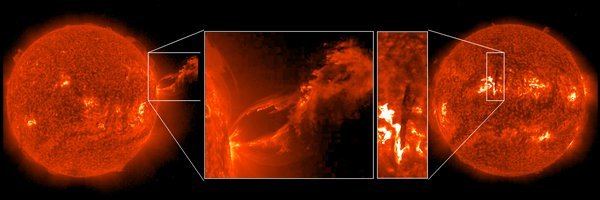
STEREO: a dual-space craft mission to investigate the solar corona and the heliosphere.
The goal of the STEREO mission is in particular to enhance our understanding about the creation of solar eruptions and coronal mass ejections, to study the propagation of mass ejecta through the solar corona into interplanetary space and to investigate the associated acceleration of energetic particles.
Since the two STEREO space craft were launched in October 2006, we have for the first time the capability to observe processes on the solar surface and in the corona from two entirely different view directions, thereby enabling the reconstruction of the associated three-dimensional plasma distribution. In recent years, major topics in the MPS groups SoCo3D (Solar Corona in 3D) and CSI (Coronal Spectroscopy and Imaging) were
- EUV loops in active regions and how they compare to coronal magnetic field models
- Polar pumes and their distribution in coronal holes
- Distribution of magnetic flux and helicity across different active regions
- 3D shape of mass ejecta and their propagation and expansion in the Sun's vicinity
- The invesigation of energetic particle fluxes in corotating interaction regions in the heliosphere inside 1 AU
Publications related to the STEREO project with contributions from MPS scientists can be found here.
The two space craft drift around the Sun on orbits with periods about 6% shorter (STEREO-B) and longer(STEREO-A) than the Earth's orbital period. As a result, STEREO-B loses 22 ecliptic longitudes degrees every year in the wake of Earth while STEREO-A gains 22 degrees ahead of Earth each year. The present position of the two space craft can be found here.
The two space craft are identically equipped and designed as mirror-symmetrical pair. Their instrumentation consists of
- SECCHI (Sun Earth Connection Coronal and Heliospheric Investigation), a remote sensing instrument consisting of five independent telescopes:
- EUVI: an extreme ultraviolet imager which observes the solar disk in four EUV lines at λ= 17.1, 19.5, 28.4 and 30.4 nm
- COR1 and COR2: two concentric coronagraphs COR1 and COR2 which monitor the corona in white light from 1.5 to about 15 solar radii
- HI1 and HI2: two off-axis coronagraphs which cover the entire space between 5 solar radii and 1 AU
- IMPACT (In-situ Measurements of Particles and CME Transients) is a monitor for the local magnetic field and for electrons and ions in a wide range of energies. Dfferent sensors provide fluxes and field strength of
- SWEA: solar wind electrons at about 1 eV to several keV
- STE: suprathermal electrons at 2 - 20 keV
- SEPT: 20-400 keV electrons and <7 MeV protons
- SIT: elemental composition up to 2 MeV/nucleon
- LET: 2-10 MeV protons and Helium ions from 16 different directions
- HET: up to 5 MeV electrons and 13.6-100 MeV protons
- MAG: in-situ magnetic field
- PLASTIC (PLasma and SupraThermal Ion Composition Experiment), measures the local composition of the solar wind particles and their enhanced fluxes when mass ejecta sweep over the space craft
- STEREO/WAVES observes radio wave bursts emitted from solar eruptions and from the front side of the plasma clouds associated with mass ejecta.
The MPS's efforts in the STEREO project concentrate on the following activities:
- contribution of instrument hardware to SECCHI and IMPACT (W. Deutsch, K. Heerlein)
- development of analysis tools for the three-dimensional reconstruction of plasma structures observed by SECCHI (B. Inhester, T. Wiegelmann)
- development of analysis tools for the three-dimensional reconstruction of the coronal magnetic field (T. Wiegelmann, B. Inhester)
- development of analysis tools for the analysis of IMPACT energetic particle measurements (R. Bucik)
- maintainance of a complete data archive of SECCHI and IMPACT observations (B. Podlipnik)











